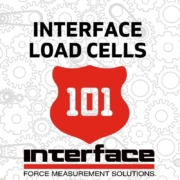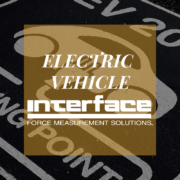Advancing Battery Possibilities with Measurement Solutions
 Advancements in batteries have opened new possibilities for the types of cars we drive, products we use in our homes, and even the way we store energy. Force measurement solutions play a crucial role in supporting advancements and innovation in battery technologies, as noted in Advancing Lithium-Ion Battery Test and Measurement.
Advancements in batteries have opened new possibilities for the types of cars we drive, products we use in our homes, and even the way we store energy. Force measurement solutions play a crucial role in supporting advancements and innovation in battery technologies, as noted in Advancing Lithium-Ion Battery Test and Measurement.
The primary areas for battery developement utilizing Interface load cells and instrumentation are design, testing, and manufacturing. From structural integrity and safety tests to material testing and optimization, Interface measurement solutions are used for evolving batteries and their applications across many industries.
Interface is a preferred provider of force measurment solutions to the automotive industry, where they have long utilized our load cells and instrumentation for different battery testing. Learn more about our battery solutions for the auto and vehicle industry here.
As batteries become more powerful, ensuring their structural integrity for safety purposes becomes paramount. Our load cells are used to accurately measure the forces during various mechanical stresses, such as compression and impact testing. These measurement solutions can help to assess their robustness and identify potential weak points of the battery structure. Read: Electric Vehicle Structural Battery Testing
Understanding how battery materials respond to forces is critical in optimizing their performance and durability. Testing new materials is critical in developing new battery capabilities and capacities. With the introduction of new battery types, there is a requirement to thoroughly assess the chemicals and materials used in the battery, it’s encasing and the surrounding environment.
Load cells can be integrated into battery testing setups to monitor the mechanical stress on batteries during charge and discharge cycles. Load cells are utilized in thermal testing chambers to measure the mechanical stress experienced by batteries during thermal cycling. Load cells that are designed for high cycle counts for fatigue and stress testing are ideal for this type of measurement.
Interface products are important in the quality control processes of battery manufacturing. By validating the mechanical properties of batteries at different production stages, manufacturers can maintain consistent quality and comply with industry standards and safety regulations. All types of batteries are regulated in many countries to ensure safety, environmental protection, and consumer rights. The specific regulations may vary; however, most batteries are designed to meet the maximum industry standards.
Advancements in battery testing are essential for a wide range of industries that rely on batteries as a crucial component of their products or operations. Some of the industries that heavily rely on battery testing include automotive, particularly electric vehicles (EVs), renewable energy, consumer electronics, manufacturers, aerospace and aviation, medical devices, military, industrial equipment,, transportation and shipping, and maritime.
How are load cells used in battery testing?
The most common types of battery testing include capacity testing, safety testing, environmental testing, and manufacturing quality control. Load cells are commonly used for battery compression tests, impact testing, and thermal expansion and contraction.
Battery Compression Testing
This is crucial to ensure the battery’s structural integrity and safety under different conditions. During compression testing, the battery is subjected to controlled forces using hydraulic or mechanical presses, and load cells placed between the battery and the press measure the applied force accurately. Engineers can analyze the data to determine how the battery deforms and behaves under pressure, helping them design safer and more robust battery packs.
Interface low profile load cells, like our popular 1200 series or through-hole load cells like our precision load washers are often used for compression tests on batteries. Low profile load cells have a flat, disk-like shape and are suitable for applications where the force needs to be applied in a perpendicular direction to the cell’s surface. Through-hole load cells, on the other hand, have a central hole through which the force is applied, making them suitable for applications where the load needs to pass through the load cell. Interface offers a wide range of models including high-capacity, compression-only, precision, and mounting options for our load cells.
Battery Impact Testing
Load cells can be integrated into a machine, drop tower or other testing setups, where the battery is dropped from a specific height to create impact. The load cells measure the impact force experienced by the battery during the fall. This data is vital for evaluating the battery’s ability to withstand sudden shocks and impacts, ensuring it meets safety standards for real-world situations.
For impact testing, high-capacity load cells with a rugged and robust design are preferred. Impact events can generate high forces in a short period, so the load cells must be capable of handling such sudden loads without damage. Interface’s S-type load cells or rod-end load cells are commonly used for impact testing applications due to their ability to measure tension and compression forces accurately.
Battery Thermal Expansion and Contraction Testing
Load cells are used in thermal testing chambers to measure the changes in mechanical stress that occur within the battery as the temperature fluctuates. By analyzing how the load on the cells changes with temperature, engineers can assess the battery’s performance and structural stability under different thermal conditions, which is critical for battery design and optimization.
In thermal testing applications, miniature load cells often used. Miniature WMC load cells are compact and can be easily integrated into small spaces within thermal chambers. Strain gages offer excellent sensitivity and are suitable for measuring small changes in mechanical stress that occur during thermal expansion and contraction testing.
Read EV Battery Testing Solutions Utilize Interface Mini Load Cells
Interface Force Load Cell Considerations Used for Battery Testing
- Capacity: Choose a load cell with a capacity that covers the expected force range during testing. Ensure that the load cell can handle the maximum force that might be applied during compression, impact, or thermal testing.
- Accuracy: Look for load cells with high accuracy and low hysteresis to ensure precise and repeatable measurements, especially when evaluating the mechanical properties and behavior of EV batteries under various test conditions. Interface is known for accuracy in measurement. All specifications related to the accuracy are available on each product’s datasheet.
- Model Design: The load cell’s form factor should be robust and durable to withstand the demands of testing. A rugged design, preferrably stainless steel, is essential for impact testing and to ensure the load cell remains stable and reliable throughout the testing process.
- Compatibility: Ensure that the measurement device is compatible with the testing equipment and data acquisition system being used in the battery testing setup. Interface will work with you in selecting the right sensor, instrumentation, cable and any accessories based on your test plan.
- Calibration and Temperature Compensation: All Interface load cells have calibration certificates. The temperature compensation features are outlined in the model specifications. Accurate calibration and temperature compensation are vital for obtaining reliable and accurate force measurements, especially during thermal testing.
- Application-specific features: Depending on the type of battery testing, certain load cell features, such as high-frequency response for impact testing or low profile designs for compression testing in confined spaces, might be beneficial. Discuss with our application engineers if you have questions on selecting the right products.
Overall, advancements in battery testing have far-reaching implications across various industries, enabling the development and deployment of safer, more efficient, and higher-performing battery technologies, which are essential for the ongoing transition to a sustainable and electrified future. To learn more about solutions that Interface has supplied for battery testing, and affiliated components used in the advancements of batteries, contact us. Our solutions team is ready to help.
Additional Resources
Electric Vehicle Battery Load Testing Feature and Application
Feature Article Highlights Interface Solutions for EV Battery Testing
EV Battery Testing Solutions Utilize Interface Mini Load Cells
Advancing Lithium-Ion Battery Test and Measurement
Electric Vehicle Structural Battery Testing App Note
Electric Vehicle Battery Monitoring
Interface Powers Smart Transportation Solutions








